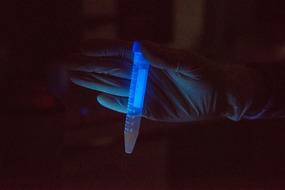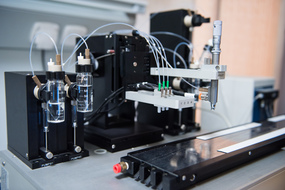Researchers from the NUST MISIS and Tezpur University (India) have synthesized a substance based on snake venom alpha-neurotoxinsandsemiconductor fluorescent nanoparticles. The new substance can effectively mark the boundaries of cancer tumors.
The ability to diagnosis cancer early and reliably is one of the most sought-after goals in biomedical research. Surgeons need to see the boundaries of the cancer: the more precisely the boundary is marked, the more effective the operation will be.
Researchers from NUST MISIS have created a unique hybrid compound (conjugate) consisting of two molecules with different characteristics —alpha-neurotoxins derived from Thai cobra venom andsemiconductor fluorescent quantum nanoparticles of cadmium selenide, the so-called quantum dots. These conjugates can be used to create medical test systems that visualize some types of malignant neoplasm.
The Indian researchers analyzed the cytotoxicity of alpha-neurotoxins, nerve growth factors, and their conjugates with fluorescent nanocrystalsin various types of cells.
Snake venom is a complex combination of proteins with various biological effects. For example,cobra and mamba venom contains alpha-neurotoxinsthat interact with specific receptors and completely block neurotransmission. In other words, snake venom causes paralysis.
The biological targets of alpha-neurotoxins are nicotinic cholinoreceptors, the specific groups of proteins which malignant tumors, such as small cell lung cancer or breast cancer, produce in pathologically large amounts.In a healthy organism, cholinoreceptors participate in neurotransmission.
Researchers used a unique characteristic of toxins — the selective interaction with cancer markers to visualize the tumor.The neurotoxin-quantum dot conjugate reaches the infected organ with the blood flow and marks the entire boundary of the neoplasm with fluorescent nanoparticles, which fluoresce when irradiated with UV light, which the human eye cannot see.
“We used specially devised methods to synthesizeneurotoxin-quantum dot conjugates that maintain stability in human use. The nanoparticles of cadmium selenide are covered with a thin film of peptide (very short protein), which explains the high biocompatibility of conjugates and helps neutralize the toxicity of the quantum dots. At the same time, these conjugates are much smaller than their analogues, which greatly simplifies the delivery of the substance into the organ,” said Professor Yury Utkin, project director and an expert at the NUST MISIS Energy Efficiency Center.
Utkin said that the use of fluorescent nanoparticles can greatly enhance the efficiency of diagnosis, becausefluorescent nanoparticles are in some ways much more efficient than traditional markers:they have a brighter fluorescence and a higher light stability.
This substance can be also used for targeted therapy if medicine is added to the conjugate molecule. It is a fact that delivering medicine to the affected organ is the top priority in case of cancer, because the bulk of cancer medicines are toxic.
The researchers are working now to streamline the substance’s characteristics and preparing for preclinical tests. Invivotestingisplannedforthenearfuture.





